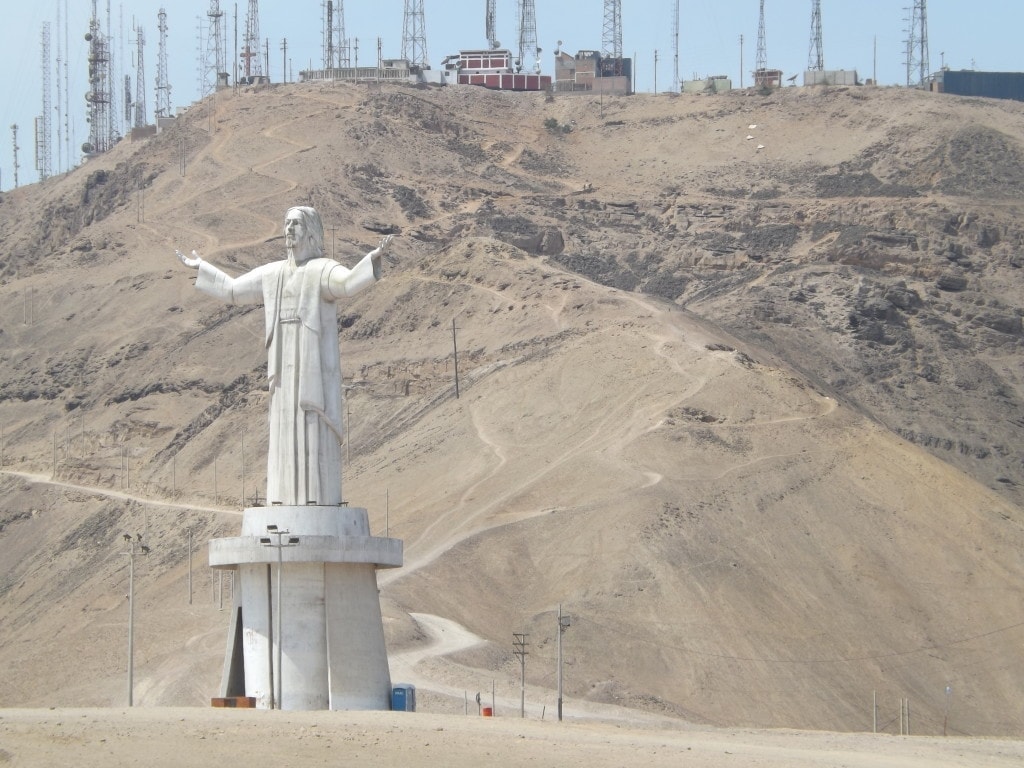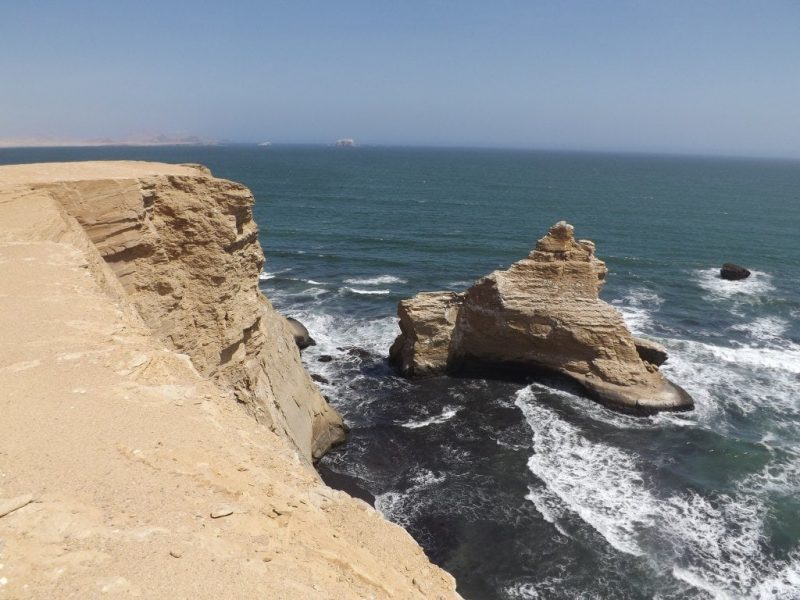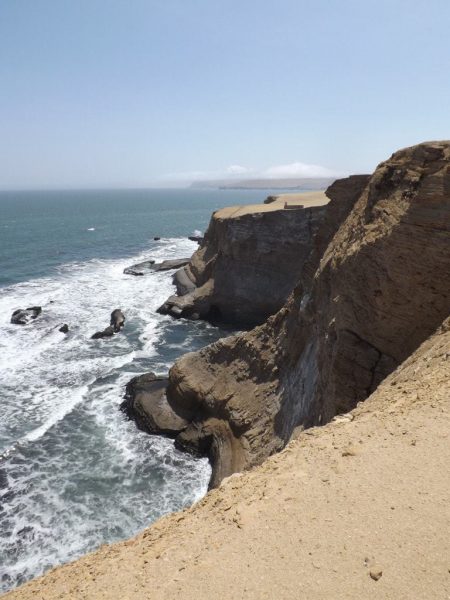Some posts on this site contain affiliate links. If you book or buy something through these links, I earn a small commission (at no extra cost to you). Take a look at my privacy policy for more information.
Travelling from Lima to Cusco on board the Peru Hop bus – the ultimate way for backpackers to see a lot in a short space of time!
From Lima, we spent a week travelling to Cusco with Peru Hop, an awesome hop-on hop-off bus company. The journey took about a week, with a few brilliant stops in between.
Calling at the seaside town of Paracas, the desert oasis Huacachina, the famous Nazca Lines, and more, we wound our way slowly from Lima to Cusco by bus.
Although the journey can be done in about 12 hours by direct bus, this is a much gentler and more pleasant way to travel into the mountains – and see a lot more of Peru on the way!
I’ve already published a review of Peru Hop, so this is a more detailed look at the journey itself, including, where we stopped and what we got up to….
Peru Hop Bus from Lima to Cusco
This write-up was first published in 2014, during my South America backpacking trip. But the Lima to Cusco bus journey with Peru Hop remains more or less the same, so I think this write-up is still useful.
At 9am, our first Peru Hop guide Paulo collected us from our hostel and took us down to the bus, where we met the rest of the travellers in our relatively small group – about fifteen.
Lima to Paracas
Our first stop was Paracas, a small seaside town about a three-hour down the coast from Lima.
Although Peru Hop offers a direct bus to Paracas, we opted to take their awesome day tour en route to the first town (only $10 more than the other buses and leaving on Mondays, Wednesdays and Fridays).

Leaving Lima
Will, the Irish expat forming one half of Peru Hop’s ownership, journeyed with us as far as the outskirts of Lima and provided the first part of the tour.
The first stop was at the Peru sign on the seafront in the Chorillos district, a great spot for photos which made a nice background for a group shot of the tour. The Peru sign is a relatively new branding – the word ‘Peru’ spelled with the spiralled ‘P’ – which you can now sea on everything from Peruvian products, to souvenires, to tourism adverts in foreign countries.
Unlike in most other countries with similar ‘branding’, the locals are really proud of their new ‘Peru’ symbol (the spiralled P is inspired by the Nasca lines) and we’d already spotted tons of locals sporting t-shirts and baseball caps with the logo.
Lima Christ Statue
From the Peru sign, we headed up to the hills above Lima, where we could view the Christ statue and other statues, as well as spectacular views across the city.

Will made an awesome tour guide, and had plenty of fascinating facts to share with us, like the fact that the Christ statue was originally planned by an over-ambitious president to be bigger than Rio’s , until the project ran out of money and they had to cut poor Christo’s legs short.
He also told us all about the Peru – Chile war and their history of poor relations, and pointed out the war memorial on top of the hill, as well as the statue of Peruvian hero Colonel Bolognesi, who when he realised he would be captured by the enemy, threw himself off a cliff holding the Peruvian flag rather that become a prisoner (this act of patriotism is highly regarded across the country, with almost every Peruvian city containing an Avenida Bolognesi that has nothing to do with a Peruvian love of pasta).
Paulo and El Silencio

After Lima, we said goodbye to Will and continued on with Paulo, stopping next alongside the Pachacamac ruins for a brief but interesting tour from the bus (according to Will, the ruins aren’t interesting enough to warrant a face-to-face visit, which judging by the size and relative disrepair of the site is probably true).
Instead, we journeyed on to El Silencio beach, completely deserted during the week and aimed more at local tourists than at backpackers like us, where we had a huge and delicious lunch of super-fresh seafood.
Peru Hop have cut a pretty good deal with one of the restaurants on the beach, who offer a two-course menu including drinks, so we ate well and were pretty sleepy by the time we got back on the bus!
Hacienda San Jose

The last visit of the day was at the Hacienda San Jose. By this point, we had swapped guides (this doesn’t usually happen – the miners’ strike road blocks the previous week had slightly messed up Peru Hop’s rotas) and were now travelling with Alexandra, who gave us a fascinating tour of the hacienda.

This was a beautiful old cotton plantation (now used as a fancy hotel and museum) with a troubling history; African slaves had been smuggled into Peru for use on haciendas such as these and had been treated pretty badly (much like on the cotton plantations in North America).
We got to see the catacombs under the house, a set of narrow tunnels which were pretty creepy and which had also once been used to assist in the smuggling of slaves, and also peeked into the ‘punishment room’, a claustrophobic little dungeon with a morbid story; disobedient slaves had their hands chained to their ankles and had to stand outside until they eventually fainted or passed out from exhaustion, contracting gangrene from the metal chains and usually dying within 24 hours.

From the hacienda, we drove the last two to three hours straight to Paracas, where the Peru Hop bus dropped us right outside our hostel, and spent the evening eating and drinking with Alex and some of our new friends from the bus (as well as our ‘stalkers’ Ben and Jake – two guys from Lima who had followed us onto the Peru Hop tour).
Peru Hop Part Two: Paracas to Hucachina
The second stage of our journey with Peru Hop was another relatively short one, this time from Paracas to Huacachina.
This tiny town surrounding an oasis in the middle of the desert is becoming increasingly popular with travellers, but at the moment public buses only travel as far as the neighbouring town of Ica, from where you need to take a taxi to Huacachina. The Peru Hop bus took us directly to our hotel in Hucachina, instead, saving us a lot of time and hassle!

Paracas National Reserve
The relatively quick journey is broken up with another small tour en route, this time to the National Reserve near Paracas, with our entrance tickets included in the initial Peru Hop fee.
The reserve is essentially a huge expanse of desert, with towering dunes and seemingly endless planes of beige-yellow sand, which has been protected for conservation reasons.
The Peru Hop bus pulled into the reserve and began making its clumsy, swaying way over a sandy, dirt track, up and down small dunes. We lurched and rolled through the desert, staring at the bizarre expanse of plain, beige sand under the vividly blue sky, until we pulled up in an empty ‘car park’ designated with a trail of stones and found ourselves face to face with a dramatic cliff line overlooking the wild Pacific Ocean.

The dark, swirling blue of the sea, flecked by strong waves, was a startling contrast to the yellow desert and the orange cliffs that stood starkly at its edge.
Sand and Cliffs
Our new guide, Nilo (we were with a new group and bus now, having ‘hopped off’ for a while in Paracas), gave us a brief but interesting tour of the reserve, starting with the viewpoint over the cliffs.
He showed us how the erosion of waves and weather, not to mention multiple earthquakes, had changed the shape of the cliff faces over time.
In fact, the huge tower of rock just opposite the cliffs used to be connected to the land by a rocky arm, with a huge cavelike space underneath known as La Catedral; Nilo could remember the structure from his childhood but, following a quake, the cathedral has collapsed and the rocky tower now stands alone, separated from the cliffs.

Red Beaches
From the first viewpoint, we headed next to a small bay where the sea was quieter, which was lined with a bright, blood-red beach. The beach is made up of red sand and tiny stones, which created a really beautiful effect, but again this is being subject to erosion and the beach is fast disappearing.
After a while on the beach enjoying the sun and the sea breeze, we headed back onto the bus for a relatively short drive to Huacachina.
Huacachina
Once there, Nillo gave us a quick tour of the oasis town, pointing out the best places to eat, and took us for a drink at Desert Nights, easily the best restaurant in town – although not particularly Peruvian.
Huacachina was such an awesome town that we instantly knew we wanted to stay there longer. So we ‘hopped off’ the Peru Hop bus, extending our stay to four days. That time was spent exploring the desert, sandboarding down the towering dunes, and lazing by the pool at our Oasis Hotel!
We also took a day trip to fly over the Nazca lines, before hopping back on board Peru Hop for the last leg of the journey…



Peru Hop Part Three: Huacachina to Cusco
The third journey with Peru Hop is the longest. For us, it was doubly long because, with a deadline to stick to, we had to skip the third stop in Arequipa and head straight to Cusco.
We started from Huacachina at about half three and didn’t reach Cusco until about six o clock the following evening; a painfully long journey by any standards.
Pisco Vineyard


We actually did the first part of the journey, a tour of a nearby Pisco vineyard, two days before so as to cut the route a little shorter. Nillo was still our guide at this stage, and drove us to the outskirts of Ica for the tour.
We headed into a vineyard and were greeted by the hot, acrid smells of rotting fruit and fermenting grapes, before Nillo handed us over to the man he said was the best guide on the vineyard, Jose.
After a very brief introduction, Jose showed us the press, which was 150 years old, and the distillery. He talked pretty quickly with a strong accent, and reeled off a ton of facts so fast that I barely followed any of it.
Still, Jose was really entertaining, and taught us a lot about the pisco and winemaking process on the vineyard. The tour was over fairly quickly, and finished, like any good pisco tour should, at the bar, where we sampled shot after shot of the various types of wine – including two known as ‘baby maker’ and ‘divorce’ wines – and piscos. I can’t say I’m a huge fan of neat pisco, but the wine was nice and it was a pretty fun experience.

Nazca Stopover
Two days after the pisco tour, we set off on the full journey to Cusco. We were travelling now with Carlos, and like all our previous guides he was really friendly and great fun.
We started with a three-hour journey to Nazca, where we stopped by the side of the empty highway to climb the three-storey-high viewing tower.
After the Nazca lines flight, this was a fairly underwhelming experience! From the tower you can only view three of the lines, the monkey, the hands and the tree. However, we were much closer and could really appreciate the size of the lines, plus the viewing tower gave us a great view of the red-gold sunset over the dusty, pinkish-brown desert plains.

Overnight Bus to Cusco
After a cheap dinner in Nazca, we bundled on board the Peru Hop bus and set off into the night.
The journey, like any overnight bus, wasn’t particularly comfortable, but an English movie and some other travellers to chat to certainly improved things.
We slept most of the night, waking up at around 5am to the pretty streets of Arequipa. The sight of snowcapped mountains in the distance was something of a shock after the intense heat and monotone yellow of the desert, but the scenery was spectacular.

Once almost everyone on the bus had gotten off at their respective hostels in Arequipa, and we’d loaded up with a new batch of travellers, we headed off again for the final ten hours of our journey.
Arequipa to Cusco Bus Ride
This is one of the prettiest bus journeys I’ve ever taken, with stunning views out both windows of the rolling valleys, snowy mountains and green forests of the Andes. About mid-morning, we stopped at a high point overlooking an enormous, glassy lake at the bottom of the valley.
The sight was incredible, with empty blue skies, green hills, and blue-tinted mountains in the far distance, and the fresh, cold air really helped to wake me up after the long journey.

Finally, about twenty-six hours after setting off from Huacachina, we reached Cusco. Conner, the second of Peru Hop’s two Irish owners, met us at the bus stop to give us a quick welcome to Cusco, and then put us all in taxis to our hostels (as the city centre roads in Cusco are way too narrow for buses).
Although any twenty-six-hour journey is bound to suck, the various stops, the lovely guide Carlos, and the company of other travellers really made a difference, and I was so glad to have travelled with Peru Hop.
However, I don’t recommend anyone skip Arequipa as we did. For one thing, it’s a lovely city (we made time to visit after Cusco), and for the other, at least one night there (or more if you want to see Colca Canyon – which you should), breaks up the journey into two, easy to manage chunks!
If you’re thinking of taking the Peru Hop bus ride from Lima to Cusco, I can’t recommend it enough. It’s a fantastic way for backpackers to pack a lot into a short space of time!




